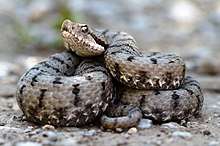Snake detection theory

The Snake Detection Theory (sometimes referred as "Snake Detection Hypothesis")[1][2] suggests that snakes have contributed to the evolution of primates' visual system. According to the theory, predatory pressure from snakes has selected individuals who are better able to recognize them, improving their survival chances and therefore transferring such skill to their offspring. From this point of view, snakes were responsible for the modification and expansion of primate visual systems which made vision the most developed sensory interface with the external environment for modern primates. In her book,[3] anthropologist Lynne Isbell writes that snakes evolved to be difficult to detect and mortally dangerous. Surviving the peril of snakes for millions of years required selective pressure favoring primates' specialized visual systems. Compared to that of other mammals, the pulvinar region of the brain – which helps to visually detect relevant objects – is disproportionately large and effective in the brains of primates (including humans).
The concept of snakes being a special threat to humans has been confirmed by population based studies. Ophidiophobia (phobia of snakes) is one of the most common and intense phobias among the general population. Furthermore, a study reported that around 50% of the people experience dreams about snakes.[4]
Empirical studies
Many empirical studies have found evidences for the theory. Primates, including humans, are able to quickly detect snakes.[5][6] Some studies have found that humans can detect snake images before subjective visual perception.[7] However, the pre-conscious detection of snake stimuli is still under debate by the scientific community.[8] Snakes images were proved to be detected more rapidly compared to other fear-relevant stimuli: empirical evidences have shown that snakes are more rapidly detected compared to spiders - according to the Snake Detection Theory - because the arachnids were, historically, a less relevant threat to primates.[9] Snake stimuli are particularly distracting during perceptual tasks, suggesting that the brain preferentially processes snake stimuli, even when attentional processes are demanded by other targets.[10] Snake enhanced detection was found also in young children.[11]
Brain imaging investigations have found further evidence for the theory. Support for the idea of a high visual sensitivity to snakes has been proven in primate neural activity in response to snake threats.[12] Non-invasive electroencefalogram (EEG) studies have found an enhanced visual brain activity in response to images of snakes in humans.[13][14][15][16][17]
References
- ↑ Isbell, Lynne A. (1 July 2006). "Snakes as agents of evolutionary change in primate brains". Journal of Human Evolution. 51 (1): 1–35. doi:10.1016/j.jhevol.2005.12.012.
- ↑ Isbell, Lynne A. (2009). "The Fruit, the Tree, and the Serpent". Harvard University Press.
- ↑ Isbell, Lynne A. (2009). "The Fruit, the Tree, and the Serpent". Harvard University Press.
- ↑ Sagan, Carl (26 September 2012). RdwC&oi=fnd&pg=PA249&dq=the+dragons+of+eden&ots=xuKU097DdW&sig=r9PWRCTXLuc0253iPHVMeg2LoJ0&redir_esc=y#v=onepage&q=the%20dragons%20of%20eden&f=false "Dragons of Eden: Speculations on the Evolution of Human Intelligence" Check
|url=value (help). Random House Publishing Group. - ↑ Ohman, A.; Flykt, A.; Esteves, F. (2001). "Emotion drives attention: detecting the snake in the grass". Journal of Experimental Psychology. General. 130 (3): 466–478. ISSN 0096-3445. PMID 11561921.
- ↑ Shibasaki, Masahiro; Kawai, Nobuyuki (2009). "Rapid detection of snakes by Japanese monkeys (Macaca fuscata): an evolutionarily predisposed visual system". Journal of Comparative Psychology (Washington, D.C.: 1983). 123 (2): 131–135. doi:10.1037/a0015095. ISSN 0735-7036. PMID 19450020.
- ↑ Ohman, A.; Soares, J. J. (1993). "On the automatic nature of phobic fear: conditioned electrodermal responses to masked fear-relevant stimuli". Journal of Abnormal Psychology. 102 (1): 121–132. ISSN 0021-843X. PMID 8436688.
- ↑ Grassini, Simone; Holm, Suvi K.; Railo, Henry; Koivisto, Mika (1 December 2016). "Who is afraid of the invisible snake? Subjective visual awareness modulates posterior brain activity for evolutionarily threatening stimuli". Biological Psychology. 121 (Part A): 53–61. doi:10.1016/j.biopsycho.2016.10.007.
- ↑ Öhman, Arne; Soares, Sandra C.; Juth, Pernilla; Lindström, Björn; Esteves, Francisco (1 February 2012). "Evolutionary derived modulations of attention to two common fear stimuli: Serpents and hostile humans". Journal of Cognitive Psychology. 24 (1): 17–32. doi:10.1080/20445911.2011.629603. ISSN 2044-5911.
- ↑ Soares, Sandra C. (15 April 2012). "The lurking snake in the grass: interference of snake stimuli in visually taxing conditions". Evolutionary Psychology: An International Journal of Evolutionary Approaches to Psychology and Behavior. 10 (2): 187–197. ISSN 1474-7049. PMID 22947633.
- ↑ LoBue, Vanessa; DeLoache, Judy S. (1 March 2008). "Detecting the Snake in the Grass: Attention to Fear-Relevant Stimuli by Adults and Young Children". Psychological Science. 19 (3): 284–289. doi:10.1111/j.1467-9280.2008.02081.x. ISSN 0956-7976.
- ↑ Van Le, Quan; Isbell, Lynne A.; Matsumoto, Jumpei; Nguyen, Minh; Hori, Etsuro; Maior, Rafael S.; Tomaz, Carlos; Tran, Anh Hai; Ono, Taketoshi; Nishijo, Hisao (19 November 2013). "Pulvinar neurons reveal neurobiological evidence of past selection for rapid detection of snakes". Proceedings of the National Academy of Sciences of the United States of America. 110 (47): 19000–19005. doi:10.1073/pnas.1312648110. ISSN 1091-6490. PMC 3839741. PMID 24167268.
- ↑ Van Strien, J. W.; Eijlers, R.; Franken, I. H. A.; Huijding, J. (2014). "Snake pictures draw more early attention than spider pictures in non-phobic women: evidence from event-related brain potentials". Biological Psychology. 96: 150–157. doi:10.1016/j.biopsycho.2013.12.014. ISSN 1873-6246. PMID 24374241.
- ↑ Van Strien, Jan W.; Franken, Ingmar H. A.; Huijding, Jorg (2014). "Testing the snake-detection hypothesis: larger early posterior negativity in humans to pictures of snakes than to pictures of other reptiles, spiders and slugs". Frontiers in Human Neuroscience. 8: 691. doi:10.3389/fnhum.2014.00691. ISSN 1662-5161. PMID 25237303.
- ↑ Van Strien, Jan W.; Christiaans, Gerwin; Franken, Ingmar H. A.; Huijding, Jorg (2016). "Curvilinear shapes and the snake detection hypothesis: An ERP study". Psychophysiology. 53 (2): 252–257. doi:10.1111/psyp.12564. ISSN 1540-5958. PMID 26481589.
- ↑ He, Hongshen; Kubo, Kenta; Kawai, Nobuyuki (10 September 2014). "Spiders do not evoke greater early posterior negativity in the event-related potential as snakes". NeuroReport. 25 (13): 1049–1053. doi:10.1097/WNR.0000000000000227. ISSN 1473-558X. PMID 25026534.
- ↑ Grassini, Simone; Holm, Suvi K.; Railo, Henry; Koivisto, Mika (2016). "Who is afraid of the invisible snake? Subjective visual awareness modulates posterior brain activity for evolutionarily threatening stimuli". Biological Psychology. 121 (Pt A): 53–61. doi:10.1016/j.biopsycho.2016.10.007. ISSN 1873-6246. PMID 27760371.